Text
You may have noticed this blog has both taken a name change (used to be 'prettypinkpansy') and also has been dormant for a couple years. That's because I've decided to change my main art blog to the name 'prettypinkpansy' for brand consistency and put the old name here, so if you're looking for l'art, it's over here yonder. Also the gamedev project is on hiatus while I prioritize other things like my health. Sorry about that. I do want to come back to it though eventually.
4 notes
·
View notes
Text
Various things
I’ve once again been falling into the trap of feeling like I need to have something meaningful to say to update here. Like some kind of grand moral to my parables. But there’s just... not always going to be that. My life and my attempts to work on a hobby project are not like, a series of stories for consumption.
So it might be kind of boring but I wanted to talk a bit about what I’ve been doing.
The aforementioned artboard has been getting some big expansions. I added a lot more stuff and organized it.
I’ve been thinking more about what the NPCs in the game will look like. Because there will inevitably be NPCs - to interact with, buy from, etc.
Been getting closer to nailing down the art style. I have a pretty good sense of what I want the girls’ outfits to look like.
Speaking of outfits, feature creep has unfortunately hit me and I am intent on making a dress-up segment where you can dress up your girls. Not only will it give bonuses to various stats, it will help differentiate the girls from each other. And also it’s cute and fun and I want it. Princess Maker and Long Live The Queen both have cute little outfits you can have your daughter wear and I grew up with dress-up games.
Watching more coding tutorials. Struggling to fully comprehend signals and their implementation. Played around with them some more in Godot. I watched this tutorial, this one, and this one as well.
That last one is terrifying because it was saying something about signals only communicating with each other if they’re a child/parent of each other which, I didn’t know, and seems bad? Maybe I misunderstood it?? Question mark??
Something something I’ll cross that bridge when I come to it and also rewatch the video until it sinks into my head.
A lot of fleshing out little details here and there, just thinking about various logistics and nailing things down.
So here’s some things I can share.
I was having trouble kind of putting together in my head an image of what the game’s architecture would look like and how the signals would talk to each other, so I came up with this rough idea using MasterPlan (not a software you need by any means but something I had on hand which worked well for the purpose). I haven’t tried implementing the bulk of this but it helped me kind of think about it better having all of the ideas outside of my head.
When trying to figure out how it would all interconnect, I kept wanting to have something kind of like sticky notes that I could drag around and attach to each other with string like some sort of fucked up gamedev conspiracy wall. This is the second best thing, I think.

And some concept art I did for some outfits:

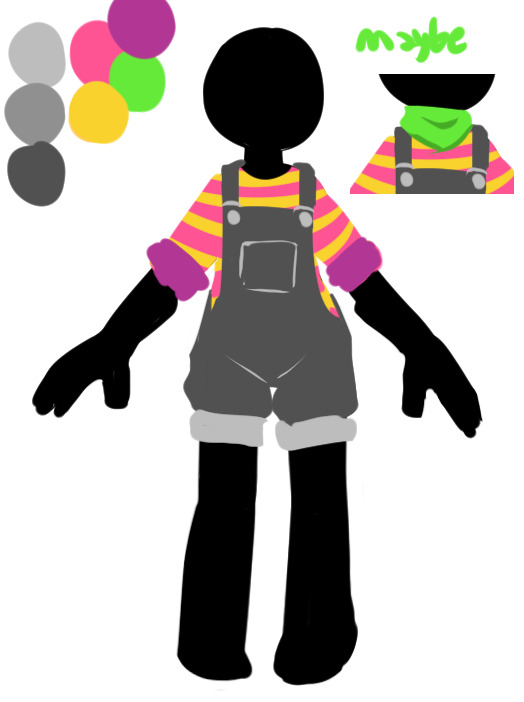
The colors are very not final, and the colors in the second are specifically for visual contrast.

My notes on outfit design. Basically, an emphasis on the child characters being children and not even remotely sexualizable. This might seem weirdly common-sense to write down, but unfortunately I am painfully aware that certain games in this genre in the past have been... designed, to some extent, for sexual gratification. Including, regretfully, Princess Maker 2 (one of the primary inspirations). There’s horny shit in there like your daughter being able to wear skimpy stuff, work at adult establishments once she gets older, increase her bust size, et cetera. Yeah! It’s nasty! Also the unsettlingly common tendency in newer works to sexualize young or young-looking characters, have them wearing very skimpy things, et cetera. Something something Fate Grand Order.
I abhor this (as anyone with good sense would, I’d hope) and so everything in the game is being carefully planned to discourage that as much as possible. Of course, pedophiles will exist no matter what you do, and some may even prefer the characters to look more childlike. But my goal is to make the game as anti-horny and Wholesome as possible. I’m taking the things that made me love Princess Maker 2 as a child, amplifying and remixing them, while cutting out the things that I find gross.


Some screenshots from my notes where I took a bunch of games from the same or similar genres (Tokimeki Memorial, Tokimeki Memorial Girl’s Side, Princess Maker 2, Cute Bite, Long Live The Queen) and wrote down their stats as well as what raises/drops them. You can see where I inserted screenshots from GameFAQS guides, lol.
I wanted to get a sense of how long it takes to increase stats, how often they’re decreased, how many stats there are, et cetera. Generally just getting a feel for what I did or didn’t like in a game and what I might like to incorporate into my own. I’m thinking 8 or 9 stats for my game so far, including that old classic, Stress. More stats can be fun, but considering we’re going to be raising 3 girls at once, the simpler the better. I might drop it even further, to something like 6 or 7 - we’ll see.
Here’s what I have down in my notes:

I’m pretty set on “Booksmarts”, “Stamina” (meant to represent physical strength), “Creativity”, and “Style”. These feel like pretty good pillars that can create a variety of diverse endings. Less certain on Fighting and Magic, though since it’s taking place in a magical universe it’d be nice to have. Affection I’m not really sure how to handle and it’s kind of a backburner thing. “Evil” would be fun, though I’m not really sure what would increase it yet. I also don’t want to copy PM2 too closely...
That’s it for this post. There’s other little things here and there. I think one of the most important things I’ve learned is to do small steps every day - and I mean REALLY small steps. If you don’t feel up to working on it, don’t, but try to think of one new idea and write it down. And inspiration and come from anywhere. I was reading a manga I liked, it had some nice classical outfits, so I took a picture and stuck it in the reference sheet.
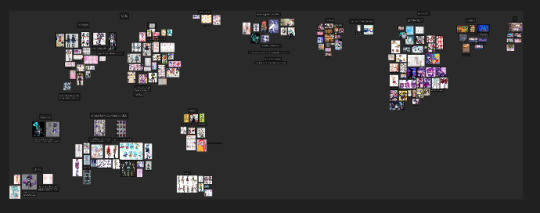
Oh yeah, here’s that. It’s gotten fucking huge, hahaha.
3 notes
·
View notes
Text
On art direction, part 1 of Who Knows
You may have noticed (or probably not noticed) that it’s been a bit since the last post!
I’ve been in a weird spot for a few weeks. I think it’s important to be honest about my struggles - and there was a bit of trouble with my ADHD meds and the pharmacy. My neurochemistry is what some might charitably call “sensitive”, and fucking up my meds didn’t just mean fucking up my concentration! Whoops.
As a result, I didn’t get much of anything done for a while. But my meds are back in order, so I’ve been slowly clawing my way towards some measure of normalcy, and am currently feeling a fair bit better!
So, what HAVE I been doing?
A little bit of everything. I wanted to center programming, but unfortunately, I didn’t really feel up to it for a while. So I’ve tried to focus on other things. Particularly, art direction.
It’s a little early on in the project, but as an artist, I’d like to figure out what my game might look like, what its characters might look like - even a really vague idea would be nice. It makes it easier to come up with more ideas from there.
One of the game dev tutorials I watched mentioned using PureRef for creating collections of references for your game, which I thought was inspired. It’s a free program I’m familiar with as an artist for building reference to create a single picture, but I hadn’t really thought to use it for more broad concepts like that. Things like setting the mood, art styles that you aspire to, scenery, UI, et cetera.
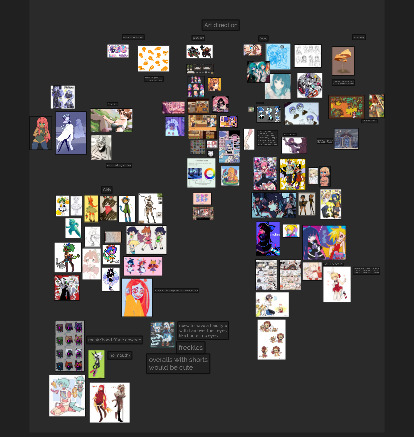
So... here’s my reference board. Zoomed out because, well, I don’t want to responsible for unsourced art floating around the internet, and also it’s a little embarrassing. It’s largely a great big soup of things I’ve found inspiring over the years, well before the idea for this game came into my head. I just finally tidied up my “art I think is cool” folder and picked out whatever felt like it could lead to some inspiration on the project.
Sorting files and looking at cool art is blessedly low-energy, so it was a good task to handle while I felt like shit. I also started searching for and adding pictures more focused on the direction of my game, not just the prime cut of three years of accumulated cool (but miscellaneous) art.
While Pinterest is controversial for how much art gets passed around without credit, it can still be a very good place to gather visual resources, and its algorithms are good enough that if you find something you’re interested in, it’s not hard to find more. I recommend it. Just don’t repost, and don’t share unsourced art!
Anatomy of a reference
One common misconception people have that I’d like to address - from both artists and non-artists! - is that using references is “cheating”.
Any sufficiently skilled artist who is not up his own entire ass will inform you that this is Bull Shit.

(Pictured: an example I made of how many references went into a single dumbass shitpost. A shitpost of a Twitch streamer doing a rap squat next to a banana wrapped in toothpaste and foil, left to rot there for 54 days.)
As you can see, while the reference images give direction, it is not a 1:1 copy. You could not place this image over any of the references used and have it look as if I’d traced it. The bottom left picture is the closest comparison, but even so, a large amount of it is improvised, and all of it is in my style. His hands kinda ended up looking more like the Trade Offer guy.
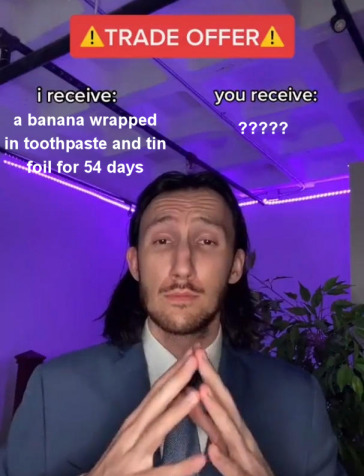
See, a picture is often an amalgam of references so far removed that it becomes its own beast. Typically a completed picture will resemble NONE of the pictures it was referenced from, or only in small parts. A foot referenced here, a hand referenced there. Like some kind of beautiful ransom note.
Of course, it’s entirely possible to reference a picture so closely that it nearly looks traced. The term I always heard for this was “eyeballing” something. Like, “I drew this while eyeballing a manga cover”. This can be morally and legally dubious. I think this is where part of the confusion comes in, vis a vis references being “stealing”.
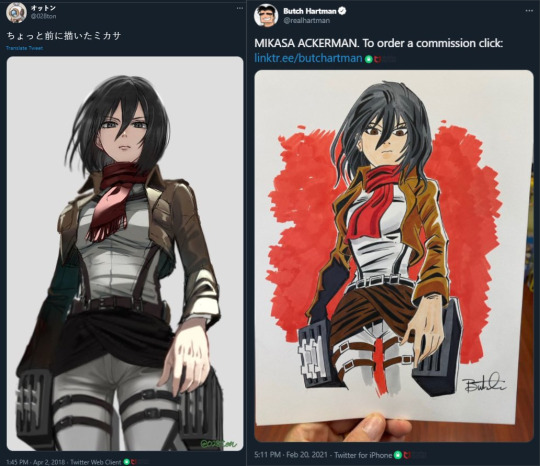
(Don’t be this fucking guy.)
But it’s not necessarily bad! Maybe you’re drawing an ultra-realistic portrait from a photo reference, or you have permission to use the reference in whatever way. A lot of free stock photo artists put thousands of pictures out there for that purpose alone, and you can reference them, trace them, etc to your heart’s content.
There’s also 3D models, if you’re especially paranoid of someone recognizing your source material. (But they are a pain in the ass.)
But this is a bit of a long preamble to get to the idea of referencing character designs. This is a contentious subject and I wanted to clarify what I typically do and how I do it, so that nobody sees “I look at Pinterest for ideas” and thinks “get a load of THIS guy”. I also wanted to set a good example for any aspiring developers reading this.
Yes, I will look at the designs of other artists as I work. But I try to only take one or two things I find interesting from a design, do this with a number of designs, and then put my own spin on it - and iterate further if it still looks too close to any one of the references. The goal is that it becomes unrecognizable.
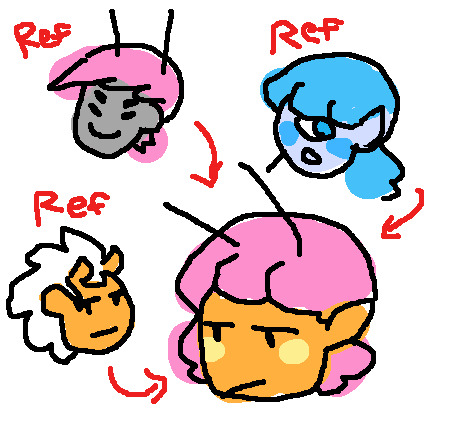
Here’s a very simplified example of the idea. In a fullbody shot, the design would look even further removed from any of these three, because it would incorporate a lot more design traits.
So, despite all of this buildup, I haven’t actually started designing any characters yet. Races, I’ve been playing with the visuals of (I’m liking the idea of raising monster girls). I’m hoping to build out my reference library for the game even further, and have a really broad amount of ideas to pull from. But it’s a good start.
I have a bit more to talk about vis a vis art direction, hence the post title, but this post is long enough already, so I’m cutting it here!
2 notes
·
View notes
Text
On coping with failure
A good friend of mine pointed out (rightfully) that I’d been doing a whole lot of talking about the game I want to make, and doing things kinda-sorta adjacent to it like working out details and the visual presentation (I’ll write about that in a later post), but not a whole lot of actually learning the engine. So I decided to really buckle down and give Godot a try.
After all, you can’t make a game with nothing but a design document - you need practical experience. And since I had next to no experience actually using the engine as opposed to watching videos, it was time to build that experience.
So I watched more of GDQuest’s Getting Started With Godot in 2021 playlist, most notably up to the “How to use Godot’s signals” video. I figured that was about all I needed to do some really basic playing around.
On the one hand, I was correct - on the other hand, I wasn’t ready for something like 3 hours of banging my head against a wall trying to get extremely basic things to work. (Given my prior experience with learning coding that was more or less exactly this, you’d think I would know better by now.)
Let’s backtrack a bit. Godot games, as far as I understand them, are largely composed of three things:
Scenes
Nodes
Signals
Nodes are your simplest building blocks. Scenes are a bit of a misnomer, because they’re more like... a container for nodes. If a scene is a toolbox, then nodes are the tools inside.
Despite the name “scene”, they are not related to scenery (I mean, they can be, but not inherently). A scene can be practically anything - so for example, a player character, an enemy, a stat bar, or, yes, your game’s scenery.
A good example is the protagonist of your game. Your Mario or your Link. They are a “scene”, as odd as that sounds. So, this scene might have a sprite node (your character’s appearance), a collision node (the hitbox), an audio node (sound that plays when you jump or get hurt), etc.
Again, it’s basically a box of parts - any components that a player character needs to function. The scene itself is a mere container and a label. Anything in your game that has a few interlocking parts, even if it’s simple? Probably a scene.

So once we’ve made our player character’s scene, what do we do with that? Well, the neat thing about scenes is that once you make a scene, you can drag them into *other* scenes. If you have an overworld scene, you can drag your player character scene in, then some enemy scenes, and an item scene... et cetera. In other words, you design various parts of your game, then put them all together in a bigger scene.
And you can use as many instances of a single scene as you want. Want 4 goombas? Drag the goomba scene in 4 times. And if your Goomba turns out to have a bug in its behavior, fixing the original Goomba scene will automatically fix it for all 4 of those Goombas.
Another neat thing is that scenes can act like nodes. In other words, you can take simple parts, create a slightly more complex object, then put it inside of a bigger object. Maybe you make an Oil Pan scene and an Engine Block scene and you add those together to make an Engine scene. Which then becomes part of your Car scene, which also has four Tire scenes, and a Wheel scene, which in itself is in a Garage scene... et cetera.
There’s no end to this nesting. You can go as simple or as complex as you want with it. It’s all made in the service of making parts of your game easier to design, reuse, and debug.
For example, you could make a base Animal scene for behavior you know you want all animals to have (like walking, eating, drinking water). Then you make a Cow scene with the Animal scene in it, but now you add some features unique to cows. And a Goat scene that does the same with features unique to goats, a Horse scene, etc. You didn’t have to program in those basic features for each animal because you created that “part” and reused it.

But it’s kind of overwhelming. And the terminology, to be frank, kind of sucks. “Scene” is just a really unnecessarily confusing term. I think it’d be much easier if you called nodes “attributes” and scenes “objects” or something, but I’m sure those words are taken by other game engines so it’d get confusing? I don’t know.
It takes a bit of getting used to. And to be honest, it’s part of why I bounced off Godot a few times. But I feel a bit more comfortable with it now.
So! Signals. Signals are how your scenes (and the nodes within) *talk* to each other. In other words, if we were making Super Mario in Godot, and Mario jumps on a goomba, how do we have Mario’s scene talk to the Goomba’s scene?
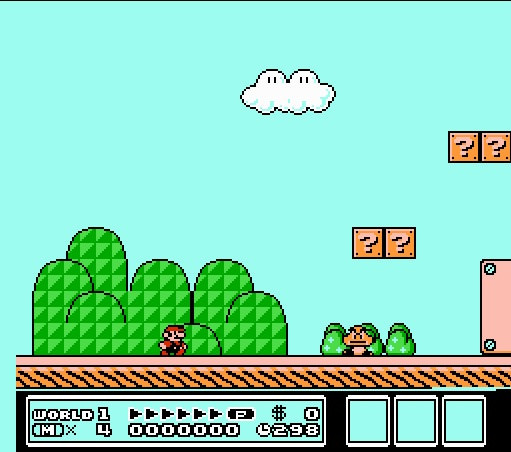
The Mario scene has a hitbox node. It detects collision, checks if it’s from the bottom (so Mario jumping on something instead of running into it), and sends out a signal. It says, hey whatever I jumped on, you should probably die now? And the Goomba scene receives that and is like, “Yeah man” and deletes itself. It’s also received by the sound node that plays a fun little noise. It’s ALSO received by the score scene, which increases score, and sends a signal to the UI scene, which is supposed to update every time the score changes.
Or maybe you jumped on spikes instead. So the hitbox node would need to check if it was an enemy you jumped on, or spikes. And if it’s spikes, it’d have to send a message to Mario’s health node to make him either lose his mushroom or die, and that would send a message to the sound node, saying “play either this sound or that sound”. Et cetera.
Once you wrap your head around it all, it’s not too bad. But there are problems like... picking the wrong node for something, because you don’t know what to choose. Or something not working and you don’t know why. Or having to redo an entire thing because you were stupid and didn’t set it up right.
Or... maybe you went about it in a really inefficient way just because you didn’t think about it right in the first place, because programming and ANY software development means learning to think about things in the most efficient ways.
These are normal steps. They’re all part of learning. You can’t really sidestep them unless you’re watching tutorials that teach you off the bat the most efficient ways to do things, but even then, you’re going to need to go off script and make your own mistakes if you want to make games beyond Baby’s First Unity Platformer.
And God, it’s normal, but it can be really irritating when it takes you three hours to do something that feels like it should’ve taken - and will, in the future - only 30 minutes.
For a bit of an odd segue...

I’ve been learning Japanese on and off for a while, and though I can’t say I’m any level of “good” at it, I’m often struck by the parallels between natural language and programming languages.
There’s often this impulse, especially if you’re a newbie, to translate a sentence or sentiment 1:1 into the language you’re learning. A few months ago I was looking up how to say “hello from America” in Japanese, as kind of a friendly “hi, sorry my Japanese sucks ass, I’m a dumbass American” sentiment. It’s a common enough sentiment you hear enough times from other overseas folks that I assumed it was fairly universal - greetings from France, and whatnot. I didn’t really think anything of it.
But Google pretty immediately told me that yes, while you can say アメリカからこんにちは (very literally, “hello from America”), it will always sound artificial and translated because it simply is not a phrase that exists in Japanese. It sounds very normal to a native English speaker, and certainly, the meaning would get across, but it comes across as odd.
It’s sort of like if I said to you, “Not like we’re riding on a rabbit’s back”. From context, you’d probably be able to glean that I meant “We’re not in a hurry”, but it would sound very strange, because that is an idiom that only exists in Finnish, not in English. (Sorry to any Finns if ei tässä jäniksen selässä olla isn’t a common phrase or something, I got that off Reddit.)
In other words, it’s not enough to know how to say every individual word in another language. It’s also about learning the right way to do things. You’re not trying to be a dictionary that translates every word 1:1. You’re trying to learn to think in another language, and abandon your preconceived notions.
You aren’t supposed to think of an English sentence and translate it. You’re supposed to think of a sentiment, a concept, one without language, and in your target language, express that in a way that is natural - as you would in your native tongue.
Programming, and developing in an engine, feels a lot like that.
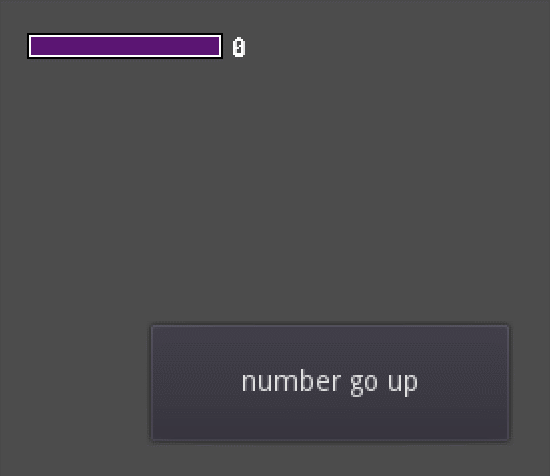
Programming is not just learning what an if/else loop and a function is. It’s learning to properly consider concepts from the very start, so that you can write them out as efficiently as possible. You have to learn how to break down broader ideas and translate them into code, or code-and-nodes-and-scenes-and-signals-or-whatever.
You have to fundamentally change the way you think about problems. You cannot look at it in the way you’re used to. You have to view it entirely through the lens of whatever tool you’re using. And, using that, you have to figure out the best, most efficient solution for the problem.
And then do that like, 200 times.
And, of course, you can’t learn the most efficient ways until you bang your head against the less efficient ways, and learn why those ways suck, and what ways work for you.
So, then, to the crux of this post: It’s honestly humiliating. And overwhelming. And I took a break for like a fucking week. My first real attempt at working with Godot, and it demoralized me so much that I stopped for a week.
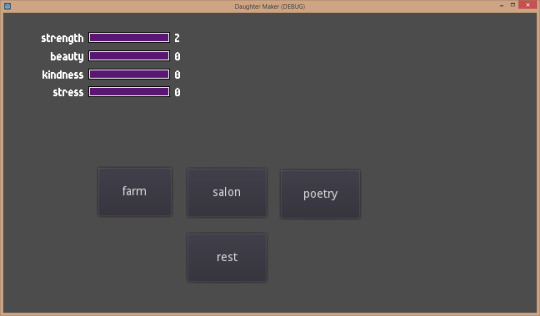
(Pictured: This took me hours, and only one of the buttons works.)
I have trouble with stumbling blocks where if I run into a significant impediment, I get very demoralized and stop. It’s derailed projects for me more times than I can count. I think a lot of ADHD people can probably relate. But the problem is - when you get used to only doing things that don’t involve a lot of failure and risk, it really limits your opportunities.
I just wanted to admit that, like, this is fucking hard, I guess. And it’s okay for it to be hard. It’s okay to be struggling to learn something no matter how old you are. But that I’m not going to give up, either. I made this blog for a reason - to stay accountable.
I am tired of leaving behind a string of failures.
I’m going to go back to watching tutorials, and see if I can’t get a little more insight into what the best way to handle certain things is (like lowering and incrementing stats). Then I’ll come back, and I’ll take another crack at it. And we’ll see what I can do.
And I will probably bang my head against the wall for another 3 hours, and accomplish far less than I’d hoped in that amount of time.
But I will have learned something. Hopefully.
14 notes
·
View notes
Text
On scope
So in my last post I mentioned scope, which is a gamedev term to mean how big your game is and, more specifically, keeping it from getting out of control. Not putting too much work on your plate, basically.
This is especially important for an amateur developer who is just starting to get into game development. Like me!
I’ve heard this a lot, but this video I watched recently helps sum it up really well. In that video they mention the concept of a “minimum viable product”. Basically, if you cut away everything that isn’t necessary, what does that look like? And is it fun?
Another video I watched related it to drawing. When you’re drawing, you do a sketch to give you an idea of the final picture, work out anatomy issues, etc. The minimum viable product is the “sketch” of your game.
So what does my sketch look like?

Here’s my “Core Features” list, or what I believe is the simplest form of this game in a “complete state”. This is a little more indepth than the video’s proposed “minimum viable product” - the example given was Mario jumping on a map with pits. No enemies, no powerups. This is more like Mario jumping on a map with pits and enemies and the occasional platform or mushroom.
To simplify it further would probably be “you have a daughter, and you can raise or lower her stats through picking between three jobs, and you can reduce her stress by resting.”
What I found really helpful was to add questions to every item. What would these actually look like? This got me thinking about the actual implementation.
(To be very clear about point 4, this was written when I was envisioning it more as making homunculi, where you could potentially create bespoke assistants for the needs of folks in town. You can’t sell kids in my game.)
Anything that did NOT feel essential was moved to a separate list. Things like missions, randomization, talking to the girls, a New Game+ system, that sort of thing. Nice to have, but ultimately unnecessary.
That said, I also created this:

This is “Core QOL”. QOL stands for “quality of life”, meaning optional features that make a game smoother and easier to play - think of an autosave system, being able to auto-sort items in an inventory, etc. Features that, while technically unnecessary, I consider to be a priority.
For example, you don’t NEED to be able to give your daughters custom names. I could just make it so that your daughters’ names are randomized. Technically speaking, it’s an optional feature!
But there’s something really special about custom names, I think. Sentimentality is what separates these games from being just a series of bars you watch go up and down. You’re forming an emotional bond with a character that you’re taking a parental role over, and it helps you feel more invested in the gameplay.
It might seem a little silly, but here’s an example of that sentimentality in action: I always name my Pokemon. I feel a lot more connected to what’s going on when I’m rooting for “WIDE LOAD” instead of “Parasect”. Suddenly, it’s not just a soulless collection of pixels that attacks when I pick the option - it’s my baby boy, WIDE LOAD, who I risked life and limb to catch even if he was 20 levels above me at the time.

And I love him so, so much.
Getting back to my list, you can see there’s a lot of “you can view the stats whenever”. Let me give some examples.
In Princess Maker 2, doing an activity will increase some stats and decrease others (e.g. working on a farm, working in a kitchen). It will not tell you which ones beforehand - you have to try them out and see. Sometimes it’s easy to guess (Farming increases strength and constitution), sometimes it’s not (Cooking decreases combat skill??). It’s trial and error.
This means that you have to write down or memorize what does what, which can be frustrating. I don’t mind the first attempt at something not giving you the info, but it should “unlock” the info so that subsequent attempts tell you exactly what stats an activity raises and lowers.
Games like Cute Bite improve upon this by telling you what stats will be increased by a job or study activity, but they don’t tell you what stat is decreased by a given job. The omission seems to be intentional, probably to make the gameplay more interesting, but I still dislike it.
Perhaps the “oops I forgot that decreases Etiquette, oh no!” is compelling gameplay for your typical gamer, but as someone with memory issues and ADHD, it just means I have to take notes. It would be cool if the game did that for me instead of having to have Notepad open while I play it.
It’s not like I want the game to play itself, and you’ll have to write down certain things anyway, like “having x stat be 100 and y stat be 150 seems to be the requirement for this character to appear” - but these are such basic things you interact with so routinely that I don’t believe automating them is bad.
To bring it back to Pokemon, recent Pokemon games tell you if an attack is super effective or not very effective. I’ve been playing these games for over 20 years, but this made them a lot more accessible and fun to me. Some folks complained about this “dumbing the games down” - as if they aren’t made for children - but I personally don’t find “ugh, right, I forgot Steel resists Psychic for some reason” to enrich my experience.
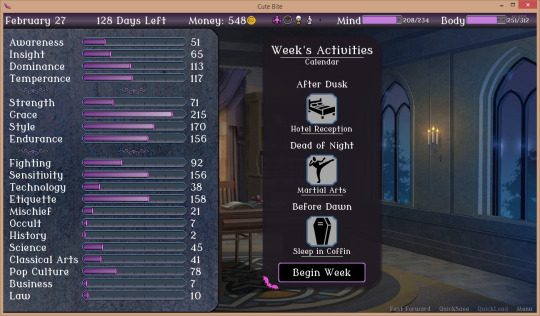
Back to raising games. So not only do you have to keep in mind what stats are increased by what, you have to remember what stats your character has and what stats you were trying to improve. Cute Bite helpfully puts the stats page next to your activity list, but Princess Maker 2 requires you to back out of your calendar entirely to look at them.
So I very often end up in a spiral of “what was I improving again?”, backing out, looking at the stats, saying “oh right”, going to the jobs, trying to remember what I was doing, et cetera. The video game equivalent of “walking into a kitchen and trying to remember what the fuck you were there to do”.
This is why I list these things as Core QOL. Backing out to look at a separate menu should be something that happens as little as possible. You should be able to, ideally, look at all the information you need on one page, or with a click or two.
Bullet point #5 (a memory album of daughters gone by) is by far the least essential one, but comes back to sentimentality. Being able to look back at the first daughter you ever made, to see her face again and what her ending was. It also does have a practical purpose - if daughter #1 was a “failure” at achieving a certain goal you were looking for, being able to look at her stats would give you some idea of what to try for with daughter #2.
All of these have the potential to be cut, but that one is the most likely. That said, all of them would be ideal to have.
There’s still the list of various features I’d like to have but don’t consider essential, but, well, this post is long enough already. But I feel pretty good about having nailed down the things I’m most invested in developing, and I feel like by working outward from there, the most necessary features should become more obvious.
2 notes
·
View notes
Text
On genres, part 2.
I’ve been trying to figure out what kind of game I actually want to make for years. Various ideas have jumped out at me, but nothing that really solidified. A few ideas for visual novels, a few ideas for horror games, and one idea that was a visual novel and a horror game...
As recently as a couple months ago, I wanted to make an I’m On Observation Duty clone that’s less horror-focused. Before that, I had some ideas for a visual novel that I was fleshing out, then lost interest.
I’ll be honest, dear reader. It’s just hard to maintain motivation and interest in one project for long when you’re me. But I’ve come across something that seems to be finally be sustaining my attention. (Or maybe that’s the Adderall working.)
In my last post, I talked about how most tutorials are 2D platformers or what have you. So to go against the grain of those tutorials means figuring out a lot of things myself. Fortunately, there is one genre that seems both (relatively) simple to create and interests me quite a lot: raising sims.
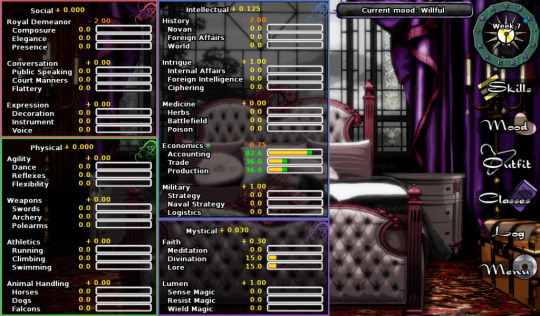
This shit gets me fucking wild.
If you’re not too familiar with raising sims, they’re a simulation game subgenre where you aim to increase stats of a character, usually with a time limit to do it in. Examples are Princess Maker, Long Live The Queen, My Lovely Daughter, Cute Bite, etc. Typically you’re raising a child to adulthood, but not always.
The appeal is the novelty of choice, as well as the various events and endings you can get. Perhaps raising your daughter’s strength makes her get a rival who wants to fight her, and she might become a swordsman at the end of your playthrough. Maybe she’s not very smart so she only becomes a lowly bandit. Raising her elegance and intelligence could get her a spot in the royal guard. That sort of thing. There’s lots of replay value, obviously.
Complications are added by having to manage a character’s stress, the fact that tasks typically decrease one stat while increasing another, and that there are undesired outcomes such as increasing a stat *too* much and locking you into an ending you’re not interested in (perhaps because you got it before).
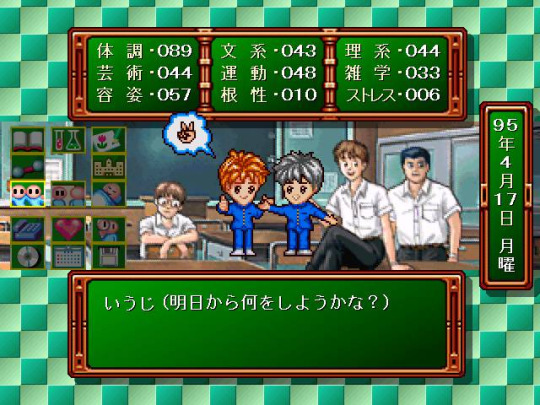
(Tokimeki Memorial is another example - while it’s typically considered more of a dating sim, the stat juggling aspects are quite similar.)
So, this arguably being my favorite genre of all time, I decided that perhaps this is what I need to focus on and develop a longer-term project.
I was quite intrigued by My Lovely Daughter, which I played recently. The game is about trying to bring your daughter back to life by creating artificial homunculi daughters, which you then sacrifice. The novelty of having not one but multiple daughters really struck me, because I’d never seen a game do that before. I also found myself really wishing I could keep my daughters alive and raise them as I pleased.
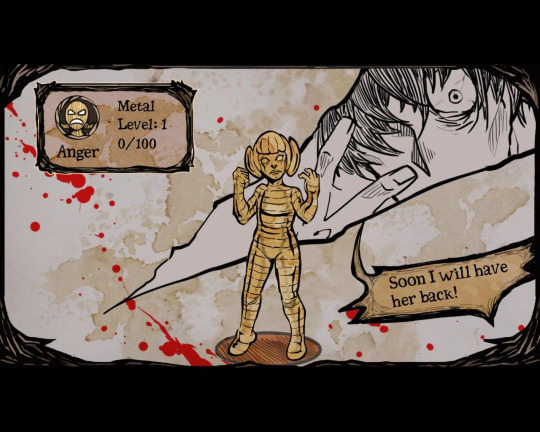
Thus came the spark of inspiration. A game similar to My Lovely Daughter in that you create and raise multiple girls, but more like Princess Maker, where you raise the girls to reach their own happy endings (rather than murdering them for your own ends). Princess Maker but on an accelerated timeframe - raising several daughters at once, potentially over a dozen over the course of an entire playthrough.
And that’s how I decided upon the basic concept of my game. Theoretically, and that’s a big “theoretically”, it shouldn’t be too hard to keep track of all their stats using basic coding things like dictionaries. But... I am a little concerned about the scope of the game.
“Scope”, if you’re not familiar, is a gamedev term referring to how big your game is, in the sense of how many features it has and how long it takes to develop. Something like “it needs a lot of endings” can very quickly spiral into an unmanageable amount of work for one person. And it’s very easy to succumb to “feature creep” - when you have a really cool game idea and you go “and it needs this, and this, and this...” and as a result, it never gets done, because you’ve penciled in way too many features to add.
So I’m working on figuring out the ideal scope. And that’ll probably be the topic for my next post. I also want to make sure the game is unique enough to stand apart from its influences - I don’t want to copy anyone wholesale.
Dealing with the skeletons in the genre’s closet
It’s worth noting that, like I talked about in my last post with Princess Maker, raising sims have often had weird and gross shit in them. In general, the idea of “you have total control over this girl’s life” has been a weird power fantasy for a lot of men - these games are historically aimed towards such men, and there are sometimes some weird... creepy... borderline pedophilic things in these games as a result.
It wasn’t really until the kids who grew up on PM2 seemingly got older and started making their own games (like Hanako Games’ contributions to the genre, like Long Live The Queen and Cute Bite) aimed at more general audiences that these games started getting less creepy, seemingly, at least in the west.
(For all I know they’ve been very diverse in Japan, but most of those games don’t get brought here, unfortunately.)
It is very important to me that any game I make not have any gross shit in it. I mean, I don’t mind the concept of adult content in games, to be clear (not that I plan to have any in this game) - but there’s “sex between consenting adults” and then there’s “you can dress your daughter up in skimpy clothing for fun! and also marry her!”. Ew.
So I’ll be working really hard to make sure the game is “wholesome”, e.g. playable by anyone without worrying about any creepy untoward shit towards the player’s daughters.
3 notes
·
View notes
Text
On genres, part 1.
The “problem” with a lot of tutorials for 2D games is that they tend to focus on things like platformers or top-down shooters. I say problem because it’s more of a me problem. For most people, this is fine.
But as anyone with ADHD will tell you, it can be quite difficult to motivate yourself to do things that you aren’t interested in.
My favorite genres are visual novels, dating sims, management games, and Harvest Moon-likes. I also love horror games and falling block puzzle games. Generally, I love things that are heavier on story and art than gameplay - games that allow you to set your own pace, for the most part. I also love games that have a lot of tedious little optional things you can do.
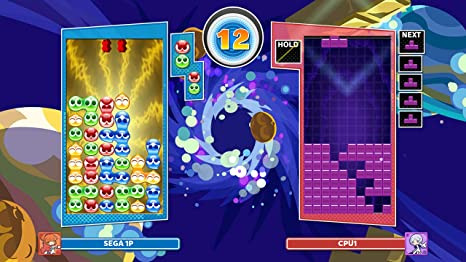
(Except the falling block games, e.g. Tetris. That’s, like, a weird exception.)
That’s not to say I’m unwilling or unable to play more fast-paced games. I’ve logged countless hours into Dead By Daylight, various shooters and Diablos, and enjoyed them. But these aren’t really the games I’m interested in creating.
To get a little personal for a second...
Alienated
Growing up, I felt very discouraged from anything that seemed like a more fast-paced or “action” title, like FPSes, or even things like Ocarina of Time. These games were treated as “for boys” back in the day (and to some extent still are - see Geguri, Annemunition, etc).
I am nonbinary, but growing up I was largely under the impression I was a girl, and internalized quite a lot of this for many years.
I’m sure there are going to be some folks reading this who are like, That’s stupid, don’t listen and just do it anyway, who lets what someone else thinks dictate what you play? And I get it. If it were voluntary, yeah, obviously I’d have chosen not to be bothered.
But when it’s a LOT of messages, and you’re THAT young, it really roots itself into you. And it’s not as if I had a lot of dissenting voices.
For a while, I saw my difficulties with these games as some sort of immutable biological truth, rather than the reasonable conclusion that you can’t be good at something you haven’t learned. A lot of girls are made to feel this way with STEM, as well. “Women can’t do math” and whatnot.
Remember how I said I see a lot of people that feel like coding is simply impossible for them? A lot of them are women!
Getting older
Once I got into my teens and twenties, I made myself play these games and found joy in them, to prove to myself that I was capable of both liking them and becoming good at them. But I’ve found that a lot of my interests - in many things, not just games - are, for better or for worse, still broadly influenced by what I was exposed to when I was fairly young.
In other words, while I definitely enjoy shooting zombies with shotguns or whatever, there is a part of my brain that goes absolutely fucking feral over things like Princess Maker 2, Harvest Moon, etc. because those are what I put hundreds of hours into when I was a child. Those are the games where I abandon all reason and spend hours drowning myself in them.
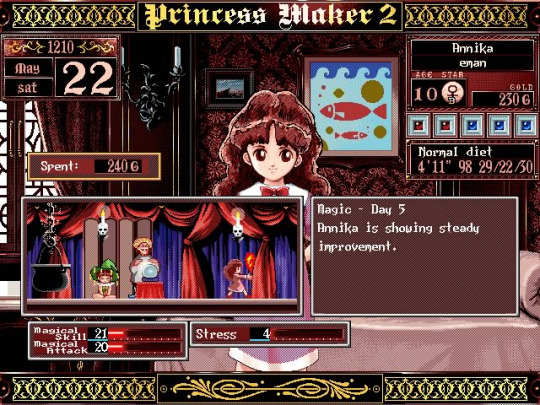
Little did I know when I was 9 years old and received a strange file from a friend over MSN Messenger named PM2.EXE that it would affect my life so profoundly!
You might be wondering why the hell I’d have latched onto dating sims and visual novels as a formative genre, being a child. Well... you can thank shitty Newgrounds dating sims for that. Yes, the porn ones. I was a weird kid. I didn’t have any interest in the porn - I was like, 10 - I just wanted to talk to the characters and raise the stats.
I also had a strange fascination with visual novels despite not having any to play, and spent a lot of time looking at their CGs. I remember going through J-List (a site that sells various Japanese products, including games) when I was around that same age, just looking at all the thumbnails for these mysterious Japanese games. I found a pack of Kanon CGs and went through them again and again despite not having any context for the visuals.
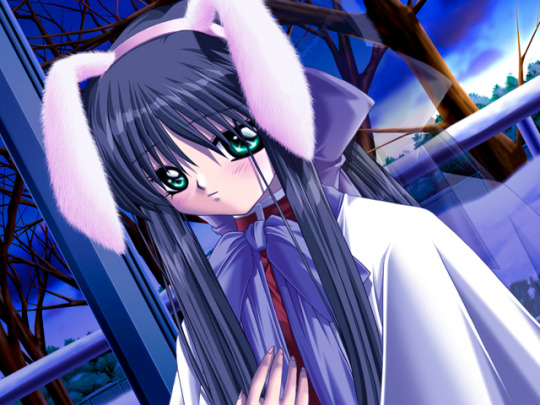
Again, I was a weird kid.
I playfully refer to all of this as “my brain being broken in a certain way”. For better or for worse, my brain magnetizes to these sorts of things.
Fortunately or unfortunately, I’m old enough now to understand that some of the things that were formative parts of my childhood are, regretfully, fucking creepy. Princess Maker 2 is a very cute game on the surface that was great for a kid like me, but it has some nasty stuff in there (like making your underage daughter work at a cabaret, or even the opportunity to marry her). Most of it can be easily avoided, but it’s still upsetting that it exists. And visual novels have a huge problem with misogyny, and sexual assault, and characters that are Legally 18 But Holy Shit They Look Like Kids.
I don’t have any illusions that American media is free from the same problem, mind, or that ALL visual novels/adjacent genres are this way. But it’s a stain on the genre. And it heavily informs the kind of game I want to make - namely, that I want it to take inspiration from the good parts of my childhood, while firmly avoiding Any Creepy Shit.
Which brings me to the kind of game I’d actually like to make. And that’s for the next post!
1 note
·
View note
Text
The search for an engine
If you don’t know what a video game engine is, it’s basically a suite of tools that you can use, a lot of which DON’T require coding, to put together a game. If you’ve ever heard of Unreal Engine or Unity, those are engines. The resulting game can be distributed to different platforms, like PC, console, or even mobile.
Unity and Unreal are free and have a bunch of resources, but they are biased towards 3D games, though they CAN be used for 2D. I knew as a 2D digital artist I wanted to make something 2D - the genres I love most (visual novels, management sims, et cetera) tend to be 2D.
Pygame was a fun diversion, but it’s unfortunately not really built to make a long, feature-complete game unless you’re intending to reinvent a LOT of wheels. You have to code a lot of things yourself, which can be good for learning things. But things that most games are expected to have, like UI, saving, loading, handling graphics, control remapping, et cetera - those are all difficult, and all part of what an engine brings for free.
The appeal is that you DON’T have to reinvent the wheel, so you can focus on what matters, which is making games.
In comes Godot.
Godot Engine is a name I hear thrown around a lot, but kind of in the way that makes it sound like nobody recommending it has actually tried it, but it sounds good on paper. It’s more 2D than 3D, but 3D IS possible. And it’s... if I’m being honest, kind of fucking weird? Like, every single object in your game (your player, your enemies, etc) is a “scene” which is a collection of “nodes” and those nest inside other scenes and...
Anyway, it’s strange, but after bouncing off it a couple times before, I’ve been finally learning about it. It’s seemingly very powerful, if you can get past the weirdness!
A big part of the reason I chose it is that Unreal and Unity require licensing depending on how big your game gets, and also depending on if you want to port it to other platforms?? Godot is completely free, and ports to a lot of things, including HTML5. In other words, they can be played in the browser! I would love to put my games in the browser so people can easily play and share them.
Unfortunately, Godot’s documentation kind of sucks. If you don’t know what documentation is, it’s like the manual that comes with your refrigerator, except for a language/program/utility/etc. And it’s usually just as obtuse.
Learning GDScript
So, the biggest obstacle to a beginner is probably GDScript. It’s Godot’s homemade programming language. You can do a lot of things in Godot without coding, but you’re gonna need to do it eventually. So you have to learn GDScript, or one of the other programming languages Godot allows (I think C# is one of them?). Python is unfortunately NOT one of them, BUT GDScript IS heavily based on Python.
A lot of Godot’s tutorials and documentation have the problem I mentioned where they’re made for people who are already familiar with programming, or they’re made for people who already know Godot Engine to quickly reference things. I bounced off them.
So what I ended up doing was making a sort of “cross reference” sheet. I watched a video on GDScript and looked at Godot’s website where they list the basics of the language, and I wrote down how you do things in Python versus how you do the same thing in GDScript (spoiler, they’re largely the same):
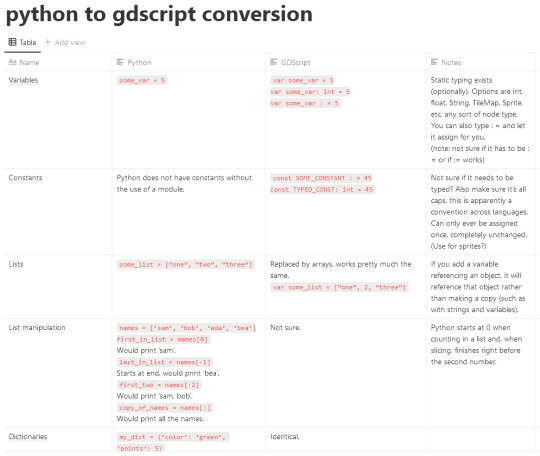
Here’s a snippet of it. This helped me to better understand the differences between the two, as well as serve as a quick reference!
I don’t know EVERYTHING there is to know about GDScript, but enough that I can feel a little more comfortable.
Learning Godot itself
Thankfully, as an open source project, Godot’s biggest wish is that more people use it, so some people have made some very ample free resources for it. GDQuest is one such resource (though some of its content is paywalled). I’ve been going through their free “Getting started with Godot” video tutorial playlist, though I haven’t finished it.
That’s about where I am now. I haven’t actually done much of anything in Godot, but I’m learning more about it using the video series, and since GDScript seems to be the biggest hurdle (as well as understanding the weird terms they use for things like scenes and nodes), I’m, you know, hopeful!
0 notes
Text
The pre-existing experience
It would be dishonest to act like I’m starting fully from zero, so I wanted to quickly go over some of my pre-existing experience with game development.
Pre-coding
I messed around in RPGMaker when I was like 9, but I can’t say I ever got very far with it. In my twenties, I did a very short experimental autobiographical game in Twine once (required no code), as well as a very short visual novel in TyranoBuilder (a visual novel maker that doesn’t require code). I screwed around in Ren’py but found it largely too overwhelming. Same with GameMaker.
I also did some HTML and CSS in my teens and twenties - extremely basic stuff, just editing existing stuff for Neopets pages and Livejournal/Tumblr layouts. I wouldn’t say this really carries over to programming languages.
If you’ve already done stuff with CSS and HTML, good news - normal code is WAY EASIER.
Coding (or trying)
Then I learned to code. At least, somewhat.
I have what I would describe as a basic grasp of coding. I learned a LITTLE bit about coding via a free code course on Javascript, but ran into a difficulty hike where I couldn’t proceed past “I know what a variable is” and if/else statements. A few years later, I learned a programming language called Python.
Coding sounds very complex and difficult if you have no experience, and most people do their best to avoid it thinking they are too dumb or whatever. But I firmly believe that not only CAN the vast majority of people learn to code, the reason most people struggle with it is because they’re using bad resources.
The problem with learning to code (for people like me)
Programming languages are less like separate languages and more like dialects - once you know one, you know most of what there is to know, and you just need to brush up on the differences between languages. So a lot of resources are not written for beginners - they’re for people who already KNOW programming.
A lot of people run into these resources, try to understand them, obviously fail, and then blame it on themselves. Imagine a piano lesson designed for guitarists, except you don’t know guitar (or any instrument).
Even when the resources are written for beginners, bad instructions exist. Teaching is a skill! When you teach without practice, you’re thinking about the most optimal way to do things, which may not be the easiest way to learn. You’re often not accounting for the mistakes that a lot of beginners make, or the questions they have, or how a lot of the terms you take for granted are things they’ve never heard before in their life.
Often I’ll google a question, find a StackOverflow result, and have to google 5 different terms to even begin to understand the answer. A lot of coding resources have these problems.
Good resources
My primary resource for learning was Python Crash Course. It’s a book that costs money, but occasionally goes on sale in Humble Bundles. It’s a book that explains Python very simply and step-by-step in a way beginners can understand.
Python is one of the simplest languages to learn, and arguably the most popular programming language in the world. As far as I can tell it’s not that good for making more complex games (more on that in a later post), but it’ll teach you both the fundamentals of coding (again, languages are dialects) and the mindset, which are the most important parts.
If you don’t have or don’t desire to spend money, Al Sweigart has a bunch of free books you can read online. I can personally vouch for having read some of Invent Your Own Computer Games With Python, which goes over a lot of the same concepts as Python Crash Course, and should probably be fine for a beginner. I’ve heard Automate The Boring Stuff With Python is good for beginners, but I haven’t personally read it.
From those two books, I learned Python and the Pygame module. I made a few programs - most of which were very unremarkable and simple, which is the ideal. You start off small, and work your way up in complexity.
If you’re a fellow ADHD haver, I know - it makes reading books hard. But these are simple books with visuals and stimulation, and you don’t have to do the exercises. And I’ll be honest - I didn’t even read the whole book. I stopped reading around the part it started giving you more indepth projects (about Chapter 12). I also got stuck on the Classes chapter and stopped reading it for like a year. But I came back, eventually.
My programs
I wrote a bunch of programs once I learned Python, which I recommend you do. Not all of them came to fruition, which is important - you can stop writing a program if you lose interest or it seems like too much work.
Some examples:

Very basic programs that didn’t really do anything, they just explored questions I had about coding. Programs don’t need to have a purpose.

A text-based adventure. This sort of thing sounds a lot more complex than it is. In reality, it was mostly just a bunch of if statements. If you don’t know what those are: they’re some of the first things you learn! It was extremely short, and had no graphics, and I made my parents play it.
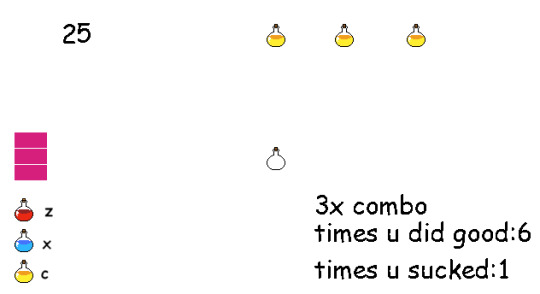
A simple proof-of-concept for a game where you make potions. It never went beyond this rudimentary layout. It didn’t really end up being fun, but it taught me a lot about Pygame.
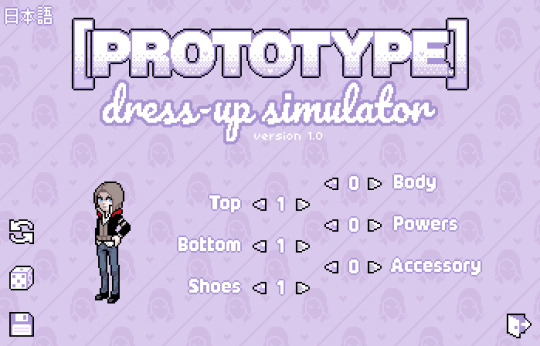
Prototype Dress-Up Simulator, a Pygame game which you can actually download and play or look at the source of yourself! It looks complicated, but it’s actually really simple under the hood - the graphics make it look fancy.
As you can see, saying I’m completely new to game development is a misnomer. That said, all of these are very simple and short programs I learned a lot by making, not full games, and the more complex ones lean heavily on the graphical side of things (because that is my strength). So don’t get intimidated. It’s just an example of how quickly you can escalate to making more complex stuff.
Anyway this post is long enough, but hopefully gives you a good idea of where I am and how I got there. If you’re following in my footsteps I’d recommend learning Python and taking small steps towards more complex programs. You don’t have to use Pygame if you don’t want to - like I said it’s not good for more indepth projects. Which will be my next post probably.
0 notes
Text
The beginning
First, I should probably talk about why I made this blog. The long and the short of it is, “to make the kind of blog I’d have wanted to read 5 years ago”.
So, I’m (sorta) new to gamedev, but I’ve always wanted to get into it. I’d like to make my own game, largely on my own - that is to say, doing the majority of the art, design, and programming myself. Maybe even the music! But part of what makes gamedev so threatening as a newbie is that it feels like the people I see talking about it are usually:
1. very experienced, and/or
2. good at coding
And unfortunately, if you’re going to be a solo dev, you’re very likely going to need to learn coding. Visual programming exists, but I believe it’s not very *good* - I’ve heard it’s buggy and has its own learning curve.
I’m an artist, and coding has always been something I’ve struggled to do. In recent years I’ve started to come around to it, but it definitely doesn’t come naturally to me, and I struggle with how obtuse a lot of coding tutorials are, especially with my ADHD.
I also know I’m not alone.
I’ve seen a lot of artists struggle to do anything with game development even though it’s clear that they have the passion to do so, but they believe coding is “something they could never learn to do”. I wanted to prove that’s wrong - that anyone, even someone who struggles like me, can learn to make a game.
And I wanted to document my learning process from start to finish, and all of the resources I find and use along the way, in the hopes that someone else can benefit from them if they have trouble like I do.
I was originally posting my thoughts on Twitter, but unfortunately Twitter sucks when it comes to long threads and finding content when it’s over a week old, so I decided to make a blog instead. I think it’ll be easier to read this way, too.
So, let’s get started!
2 notes
·
View notes